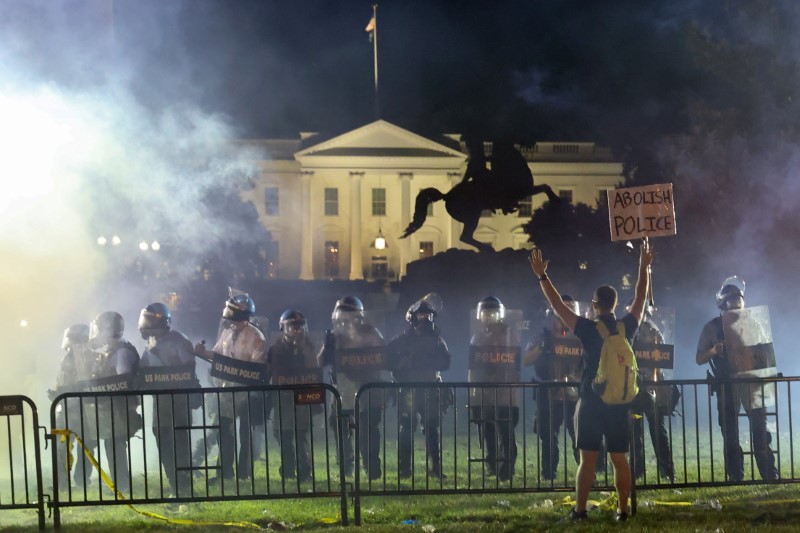
By Brendan O’Brien and Carlos Barria
MINNEAPOLIS (Reuters) – Fires burned near the White House, stores were looted in New York City and Southern California, and a tanker truck drove into marchers in Minneapolis as the United States struggled to contain chaotic protests over race and policing.

A protester runs while looting after marching against the death in Minneapolis police custody of George Floyd, in the Manhattan borough of New York City, U.S., June 1, 2020. REUTERS/Eduardo Munoz
National Guard troops were deployed in 15 states and Washington, D.C. in an attempt to quell a sixth night of violence on Sunday. The unrest began with peaceful protests over the death of a black man, George Floyd, in police custody.
“I hate to see my city like this but at the end we need justice,” said 18-year-old Jahvon Craven as he stood on an overpass watching protesters below on Interstate 35 in downtown Minneapolis moments before an 8 p.m. curfew went into effect.
Video footage showed a white Minneapolis police officer kneeling on the neck of Floyd, 46, for nearly nine minutes before he died on May 25.
His death caused outrage across a nation that is politically and racially divided during a polarizing presidential campaign, reigniting protests that have flared repeatedly in recent years over police killings of black Americans.

A protester rises from his chair as a tear gas canister stops at his feet during nationwide unrest following the death in Minneapolis police custody of George Floyd, in Raleigh, North Carolina, U.S. May 31, 2020. REUTERS/Jonathan Drake
Authorities imposed curfews on dozens of cities across the United States, the most since the aftermath of the assassination of Martin Luther King Jr in 1968 — also during an election campaign and in the upheaval of anti-war demonstrations.
President Donald Trump has condemned the killing of Floyd and promised justice, but has also described the current protesters as “thugs”.
“Get tough Democrat Mayors and Governors,” Trump, a Republican, said on Twitter on Sunday afternoon. “These people are ANARCHISTS. Call in our National Guard NOW.”
In Louisville, Kentucky, WLKY-TV, a local CBS affiliate, reported that a man was shot and killed by police early on Monday. It was unclear if he was protesting. Police said they had been fired on before the shooting, WLKY reported.

A protester pleads with riot police during nationwide unrest following the death in Minneapolis police custody of George Floyd, in Raleigh, North Carolina, U.S. May 31, 2020. Picture taken May 31, 2020. REUTERS/Jonathan Drake
CHAOTIC SCENES AROUND WHITE HOUSE
In Washington, D.C., protesters set fires near the White House on Sunday. The smoke mixed with billowing clouds of tear gas as police sought to clear from the area crowds chanting “George Floyd”.
Sporadic violence broke out in Boston following peaceful protests as activists threw bottles at police officers and lit a cruiser on fire. Philadelphia announced a 6 p.m. to 6 a.m. curfew.
On Sunday afternoon, a tanker truck drove into demonstrators on the I-35 highway in Minneapolis, which had been closed to traffic. The driver was pulled from the cab and beaten by protesters before police took him into custody. It did not appear any protesters were hit by the truck.
On the West Coast, there were also clashes in Portland, Oregon, where TV footage showed small fires burning as police fired tear gas at protesters who set off fireworks.
In Santa Monica, California, upscale stores were looted along the city’s popular Third Street Promenade before police moved in to make arrests. The vandalism followed a largely peaceful march.
Further south, in the Los Angeles suburb of Long Beach, a group of young men and women smashed windows of a shopping mall and looted stores before they were dispersed before a 6 p.m. curfew.
The demonstrations brought out a diversity of people.
“It means a lot to see people other than black people joining the demonstration,” said Candace Collins, a young black woman at a march in Culver City, California.
Thousands of people gathered peacefully on Sunday afternoon for a rally in St. Paul, adjacent to Minneapolis, as state troopers surrounded the state capitol building. About 170 stores in the city have been looted, its mayor told CNN.
Protests spread around the globe, with events in London and Berlin on Sunday and others on Monday including in New Zealand, Australia and the Netherlands.

Police in riot gear keep protesters at bay in Lafayette Park near the White House in Washington, U.S. May 31, 2020. REUTERS/Jonathan Ernst
NO LET-UP
The eruptions of violence have not let up despite the arrest on Friday of former Minneapolis police officer, Derek Chauvin, 44. He has since been charged with third-degree murder.
In New York City, where store windows were smashed, police arrested about 350 people and 30 officers suffered minor injuries during clashes. Mayor Bill de Blasio said police conduct was being investigated, with videos showing a police vehicle lurching into a crowd of protesters who were pelting it with debris in Brooklyn.
De Blasio said he had not seen a separate video showing an officer pulling down the mask of a black protester to spray something in his face.
Among those arrested for unlawful assembly on Saturday night was de Blasio’s 25-year-old daughter, Chiara, according to a New York Police Department source, who said she was issued a “desk appearance ticket” and released.
Protests have also flared in Chicago, Seattle, Salt Lake City, Cleveland and Dallas.
(Reporting by Brendan O’Brien and Carlos Barria in Minneapolis; Additional reporting by Peter Szekely, Maria Caspani and Sinead Carew in New York, Susan Heavey in Washington, Brad Brooks in Austin, Texas, Zach Fagenson in Miami and Bill Tarrant and Dan Whitcomb in Los Angeles and Aakriti Bhalla; Writing by Dan Whitcomb and Alex Richardson; Editing by Bill Tarrant, Lincoln Feast and Timothy Heritage)
















